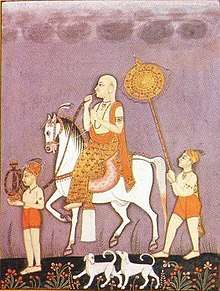Shahu I
| Shahu I | |
|---|---|
| Chhatrapati of the Maratha Empire | |
 | |
| Reign | January 12, 1708[1] –December 15, 1749[2][3] |
| Coronation | January 12, 1708, Satara[4] |
| Predecessor | Shivaji II |
| Successor | Rajaram II |
| Born |
18 May 1682 Gangoli Fort, Mangaon[5] |
| Died |
15 December 1749 (aged 67)[6] Rangmahal Palace, Satara[6] |
| Spouse | Savitribai[7], Ambikabai[7] |
| House | Bhonsle |
| Father | Sambhaji |
| Mother | Yesubai[8] |
| Religion | Hinduism |
Shahu (1682–1749 CE) was the fifth Chhatrapati of the Maratha Empire created by his grandfather, Shivaji. He was son of Sambhaji, Shivaji's eldest son and successor. Shahu, as a child, was taken prisoner along with his mother in 1689 by Mughal sardar, Zulfikar Khan Nusrat Jang[9][10] After the death of Aurangzeb in 1707, leading Mughal courtiers released Shahu with a force of fifty men, thinking that a friendly Maratha leader would be a useful ally.[11]At that time he fought a brief war with his aunt Tarabai in an internecine conflict to gain the Maratha throne in 1708.[12][13]
Under Shahu's reign, Maratha power and influence extended to all corners of the Indian subcontinent. However after his death, power moved from the ruling chhatrapati to his ministers (the Peshwas) and the generals who had carved out their own fiefdoms such as the Shindes, Holkars, Gaekwad and Bhonsle of Nagpur.
Expansion of the Empire
Early in his reign, Shahu appointed Balaji Vishwanath as his Peshwa. Over the next fifty years, Balaji followed by his son, Bajirao I and grandson Balaji Bajirao with help of capable military leaders such as Shinde, Holkar, Gaekwad, Pawar and Bhonsle of Nagpur expanded Maratha power in all directions of the Indian subcontinent. [14][15].
Family
Shahu had four wives and fathered four daughters. He also adopted two sons, Fatehsinh I and Rajaram II of Satara (who succeeded him as the Raja of Satara). Rajaram II had been brought to him by Shahu's paternal aunt, Tarabai, who initially claimed that the young man was her grandson and a descendant of Shivaji, but later disowned him as an imposter.[16] After Shahu's death the powers were indirectly shifted to the Peshwa Balaji Bajirao.[6]
Death and succession
Shahu died in 1749. His adopted son Rajaram II of Satara claimed to be Tarabai's grandson and succeeded him. But the actual power was held by others: first by Tarabai and then by Peshwa Balaji Baji Rao.[16]
| Preceded by Shivaji II |
Chhatrapati of the Maratha Empire 1707–1749 |
Succeeded by Rajaram II of Satara |
See also
References
- ↑ Mehta 2005, p. 55.
- ↑ Mehta 2005, p. 314.
- ↑ Rameshwarprasad Ganeshprasad Pandey (1980). Mahadji Shinde and the Poona Durbar. Oriental Publishers & Distributors. p. 3.
Shahu ruled for about forty-two years from January 12, 1708, to December 15, 1749
- ↑ Pī. E. Gavaḷī (1988). Society and Social Disabilities Under the Peshwas. National Publishing House. p. 5.
At last Shahu emerged victorious and ascended the throne at Satara on 12th January, 1708.
- ↑ Mehta 2005, p. 51.
- 1 2 3 Mehta 2005, p. 181.
- 1 2 Mehta 2005, p. 177.
- ↑ https://archive.org/stream/rukaatialamgirio00aurarich#page/152/mode/2up
- ↑ https://archive.org/stream/rukaatialamgirio00aurarich#page/152/mode/2up%7C Rukaat-i-Alamgiri page 153
- ↑ Maharashtra State Gazetteers: Buldhana. Director of Government Printing, Stationery and Publications, Maharashtra State. 1976.
Shahu, the son of Sambhaji along with his mother Yesubai, was made a prisoner
- ↑ Manohar, Malgonkar (1959), The Sea Hawk: Life and Battles of Kanoji Angrey, p. 63
- ↑ A. Vijaya Kumari; Sepuri Bhaskar. "Social change among Balijas: majority community of Andhra Pradesh". MD. Retrieved 2011-06-24.
- ↑ Sen, Sailendra (2013). A Textbook of Medieval Indian History. Primus Books. pp. 201–202. ISBN 978-93-80607-34-4.
- ↑ Stein, B. (2010). A history of India (Vol. 10). John Wiley & Sons page= 187
- ↑ Gordon, S. (1993). The Marathas 1600–1818 (Vol. 4). Cambridge University Press, pages 121–130.
- 1 2 Biswamoy Pati, ed. (2000). Issues in Modern Indian History. Popular. p. 30. ISBN 978-81-7154-658-9.
Bibliography
- Mehta, Jaswant Lal (2005). Advanced Study in the History of Modern India 1707-1813. Sterling Publishers.
External links
- Imperial Gazetteer of India, v. 2, p. 441.
- Kasar, D.B. Rigveda to Raigarh making of Shivaji the great, Mumbai: Manudevi Prakashan, Rs. 165 (2005).
- Akkalkot, Solapur district gazette
| Wikimedia Commons has media related to Chhattrapati Shahu. |